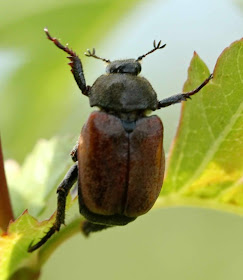Now that the main course has ended until the autumn, we are just having a couple of weeks of one-off specials. On Wednesday our destination was beautiful Brockadale. It was not the easiest place to get to. At first we were hampered with overnight roadworks which had overran. We were warned the delay would last 15-20 minutes, but the delays actually lasted an hour. There was no way most of the participants were going to arrive for the later-than-normal arrival time of 10. When we did get to the area we found that the directions given in the latest YWT reserve book were inadequate, and google maps recommended the use of Leys Lane & Hodgsons Lane, which weren't labelled as such on the ground. However, people with Sat Navs were able to see Leys Lane on their machines, and they helped everyone else find the venue.
Banded Demoiselles (c) 2013 Maggie Bruce
Record Shot of Bullfinch
Chrysalid of Burnet Moth (c) 2013 Maggie Bruce
Caterpillar of Burnet Moth (c) 2013 Maggie Bruce
Once we arrived things began very well. At first it seemed a floral delight with Rock-Rose, Kidney Vetch, Marsh Orchids, Gorse, various grasses and Greater Knapweed just starting to flower. A Yellowhammer was singing and then a Bullfinch was heard making its melancholy call, but then it perched in the open for all to see. Shortly afterwards Carole spotted a bright orange large butterfly - she had found a Dark Green Fritillary. This is not a species we see very often in East Yorkshire. Meanwhile a few Marbled Whites flitted about, as did some Chimney Sweeper Moths. We were looking at finches at the top of some Hawthorns when Anthony spotted a distantly perched Brimstone. This was to become a species that punctuated the remainder of our visit.
Froghopper (c) 2013 Maggie Bruce
Chafer Beetle Species (c) 2013 Maggie Bruce
Chafer Beetle Species (c) 2013 Maggie Bruce
Brimstone
Chimney Sweeper (c) 2013 Aileen Urquhart
Chimney Sweeper (c) 2013 Maggie Bruce
Meadow Cranesbill (c) 2013 Maggie Bruce
Clustered Bellflower (c) 2013 Maggie Bruce
Orchid Sp (c) 2013 Maggie Bruce
Dark Green Fritillary
Ditto
Rock-Rose
Rock-Rose
Goatsbeard (c) 2013 Maggie Bruce
We followed the path down to a stream (the River Went), and here Jeny spotted an unusual, colourful insect flitting around a large clump of nettles - it was a male Banded Demoiselle. We were then able to see more males, and eventually a female. It was easier to see more standing on the old wooden bridge as we looked down into the reeds. Many participants had never seen these insects before, as they are scarce insects in East Yorkshire.
Male Banded Demoiselle
Female Banded Demoiselle
Banded Demoiselles (c) 2013 Maggie Bruce
Banded Demoiselles (c) 2013 Maggie Bruce
Banded Demoiselles (c) 2013 Maggie Bruce
Banded Demoiselles (c) 2013 Aileen Urquhart
We then went for a long walk in the wood, but the sightings were fewer and further between. The most memorable encounter for me was a strange scratching and stinging sensation near my thumb. Looking I saw an enormous ginger bumble bee. I managed to shake it off before the sting entered too deeply, and sucked out the unpleasant-tasting poison, but a white bubble did blow up during the walk, before eventually subsiding. We heard a Whitethroat singing before entering the wood, and later we could hear a Blackcap, a Chiffchaff, and then very briefly a Willow Warbler sang out. Occasionally we glimpsed the attractive slow-moving river, and there did seem to be some suitable nesting banks for Kingfishers and Water Voles, but both these species evaded our attention. We did discover a Song Thrush which had frozen on a branch with food in its bill. Later, it was clear that it was trying to ensure a Grey Squirrel didn't eat its nestlings. Let's hope it was successful.
Chicken of the Woods?
Song Thrush
We returned to our Banded Demoiselle location where they were actually seen mating. There was a young Chiffchaff in this area, and our arrival was serenaded by another Song Thrush. There were quite a few Brimstones in this area now, plus an Orange Tip and another Bullfinch could be heard.
Ditto
Chafer Beetles Species
Chafer Beetle Species
Chafer Beetle Species
We returned to the lovely meadow area, and this time great hosts of beetles could be seen flying around and mating on Hawthorn bushes. These seemed to be stubbier, rounder versions of the more commonly found Click Beetles. I'd never seen them before, so I'm unsure what species they are. There were more Marbled Whites and a few Common Blues, but we didn't relocate the Dark Green Fritillary. Everyone agreed it was a lovely reserve in a beautiful setting, which was only aided by prolific Poppy and Oilseed rape fields which surrounded us on every side - so, this green jewel of a reserve was surrounded by gaudy splashes of colour.
































No comments:
Post a Comment